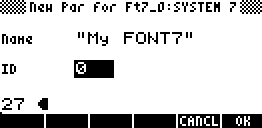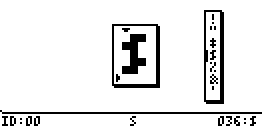 valid until
the next warmstart if no precautions have been made, see Remark 1 below.
But
creating a new font means more. After character modification it has to
be given new font parameter, i.e., a new font
name and font number or font ID which is a number. This is readily done with pressing the
command SetFP on the font in level 1. Then the right-hand dialog screen
appears. The old font paramenter are the intial values in the two dialog
fields, waiting on change. Font
parameter are parts of the font itself. You recognize the old parameter also in the
dialog box header which informs on the font size, in addition,
The same can be done with minifonts but in a different dialog screen. Fontman
contains also a powerful font browser. You can toggle the builtin fonts,
recall the current font, and each sort of a font can easily made the actual
one The package includes as an example of a self-made font LFONT7.F. Fontman has been tested under ROM versions 19-6 and
1.22 on the HP49G+.
valid until
the next warmstart if no precautions have been made, see Remark 1 below.
But
creating a new font means more. After character modification it has to
be given new font parameter, i.e., a new font
name and font number or font ID which is a number. This is readily done with pressing the
command SetFP on the font in level 1. Then the right-hand dialog screen
appears. The old font paramenter are the intial values in the two dialog
fields, waiting on change. Font
parameter are parts of the font itself. You recognize the old parameter also in the
dialog box header which informs on the font size, in addition,
The same can be done with minifonts but in a different dialog screen. Fontman
contains also a powerful font browser. You can toggle the builtin fonts,
recall the current font, and each sort of a font can easily made the actual
one The package includes as an example of a self-made font LFONT7.F. Fontman has been tested under ROM versions 19-6 and
1.22 on the HP49G+.
What is new ?
Version 8.2003: Double-click replaced by longhold to maintain one version for both the HP49 and HP49+.
Version 7.2003: command menu modified. MiniF normally clicked is a minifont viewer, double-clicked a minifont editor.
Version 6.2003: FPAR renamed to SetFP
Version 3.2003: System font toggler added, MFed and MFVw on the same key with double-click.
FIRST version 1.2003 (January 2003)
Fontman has a one-page menu with the commands
Font-> SetFP SelFt SyFt~ MiniF ->Font
described below. Read this description carefully. It refers as usual
to RPN mode only.
| Font-> | Recalls the current font. A minifont can be recalled with MiniF. Instead of modifying the currend font directly in the Character browser (key 42.3) you may also press DownArrow on it after recalling it to the stack. The advantage is that you may give it a new identiy with SetFP below. |
| SetFP
(Set Font Parameter). |
Looks for a font on the stack with perhaps already modified, to give it a new name and new font ID. Just overwrite the old ones as illustrated in the screen-shot above. The new name can be any string, even empty, The chosen ID will be recalculated modulo 256, the maximal font ID. It should actually be < 245 provided the font is destinated for export. The reason is that the font ID is used by the font stylers under EDIT/Style. These stylers do correctly interprete a font ID only if it is < 245. A font has also a font size, the maximal hight of characters in pixels, 6, 7 or 8, which cannot be changed for obvious reason. |
| SelFt
(Select a font) |
A browser on all external fonts and minifonts in the builtin ports. It none is found, SelFt offers only the next builtin font smaller to the current one. Port names of fonts or minifonts must have the shape Name.F since SelFt looks for port names with suffix .F only. Pressing the selected font or minifont makes it the actual one. For having some external font available for comparison, store the included Lfont7.F in port 2, say. Since a font takes over 2 KB, we suggest to store it as a self-decompressing object, see Remark 2 below. |
| SyFt~ | Cycles through the three builtin fonts in descending order. The valid font is displayed in the Header. |
| MiniF
(Minifont manager) |
If normally clicked views the current minifont and returns
it to the stack.While viewing one may browse through the screen with the
arrow keys. If MiniF is hold a bit longer it edits the current minifont as displayed
in the screen-shot. A minfont has no font name but only a font ID. The
builtin minifont has ID 0, to be changed with the Rightshift or Leftshift
key. The actual ID is visible in the menu area. Character browsing is done
with + and -. Each littls square represents one pixel. The screen-shot
scans just the $-symbol and we clearly see how it was made. With the arrow
keys one can modify a scanned characters. +/- toggles the black/white square.
The backspace key blanks the character. Browsing on + and - has a Slow/Fast
choice on key S, displayed in the menu area. Important: The edited
minifont is returned to the stack only if some character has been modified.
You can set the modified minifont as your personal minifont but also offer
it to the public.
If MiniF is hold a bit longer it edits the current minifont as displayed
in the screen-shot. A minfont has no font name but only a font ID. The
builtin minifont has ID 0, to be changed with the Rightshift or Leftshift
key. The actual ID is visible in the menu area. Character browsing is done
with + and -. Each littls square represents one pixel. The screen-shot
scans just the $-symbol and we clearly see how it was made. With the arrow
keys one can modify a scanned characters. +/- toggles the black/white square.
The backspace key blanks the character. Browsing on + and - has a Slow/Fast
choice on key S, displayed in the menu area. Important: The edited
minifont is returned to the stack only if some character has been modified.
You can set the modified minifont as your personal minifont but also offer
it to the public. |
| ->Font | Make a font or minifont from the stack the actual font or minifont, respectively. |
Remark1. If you want a self-made or imported font to remain stable after a warmstart you must tell this to STARTUP. Similarly for imported minifonts.
Remark 2. SelFt strenghtens the builtin font browser in
that it looks also for minifonts, and you need not search in the memory.
A font or minifont can be a self-decompressing code, easily made with the BZ-tools from OT49(+). Self-decompression does not depend on
the presence of this library but
is simply done by EVAL. One has only to take care that a port name evaluating
to a font has the suffix .F to be included in the font browser of Fontman.
Wolfgang Rautenberg - raut@math.fu-berlin.de - www.math.fu-berlin.de/~raut
CREDITS. The minifont tools stem essentially from MNF v1.3 by Philippe
Pamart. The program of SetFP uses character string processing, an
idea of Joseph K. Horn.